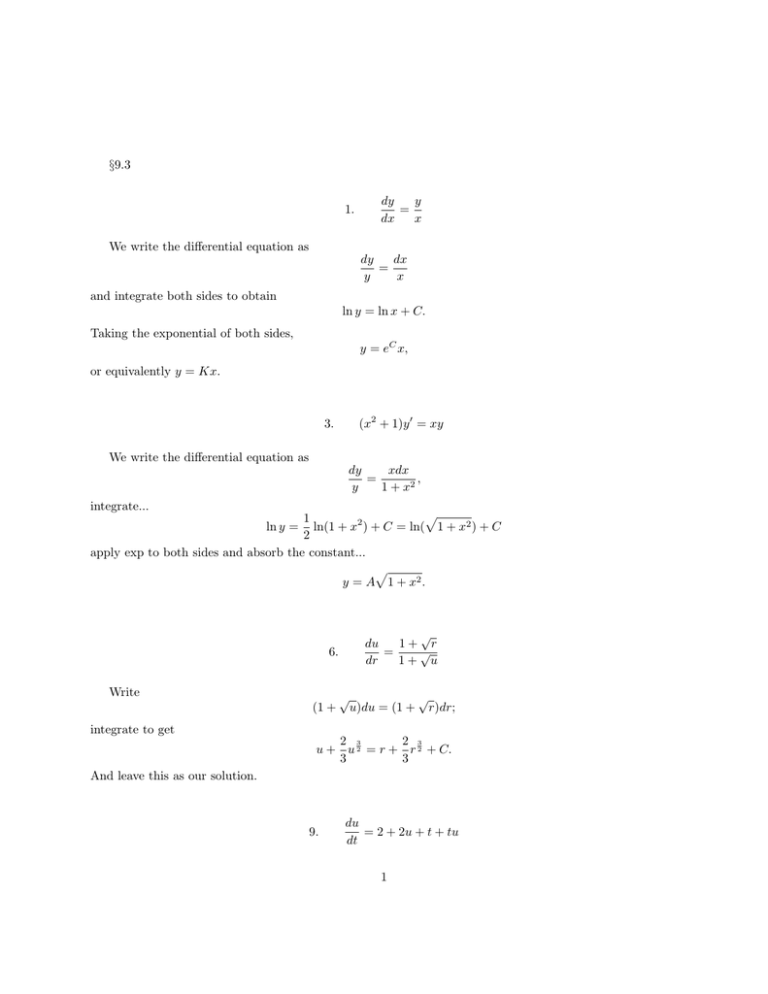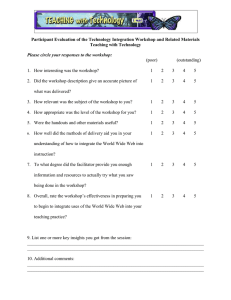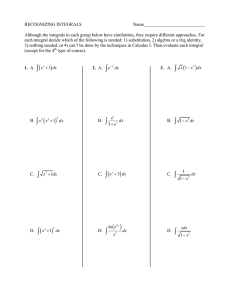9.3 1. dy dx = yx We write the differential equation as dy y = dx x and
advertisement

§9.3 1. dy y = dx x We write the differential equation as dy dx = y x and integrate both sides to obtain ln y = ln x + C. Taking the exponential of both sides, y = eC x, or equivalently y = Kx. (x2 + 1)y 0 = xy 3. We write the differential equation as dy xdx = , y 1 + x2 integrate... p 1 ln(1 + x2 ) + C = ln( 1 + x2 ) + C 2 apply exp to both sides and absorb the constant... p y = A 1 + x2 . ln y = √ du 1+ r √ = dr 1+ u 6. Write (1 + √ u)du = (1 + √ r)dr; integrate to get 2 3 2 3 u + u 2 = r + r 2 + C. 3 3 And leave this as our solution. 9. du = 2 + 2u + t + tu dt 1 We have du dt = (2 + t)(1 + u), which we rewrite as du = (2 + t)dt, 1+u integrate... t2 +C 2 apply exp, absorb the constant, and subtract 1 from both sides ln(1 + u) = 2t + t2 u = Ae2t+ 2 − 1. 11. We rewrite the DE dy = y 2 + 1, dx y(1) = 0 dy = dx +1 y2 integrate... tan−1 y = x + C evaluate at x = 1, tan−1 y(1) = tan−1 0 = 0 = 1 + C, so C = −1. Therefore y = tan(x − 1). 13. x cos x = (2y + e3y )y 0 , y(0) = 0 We separate, x cos xdx = (2y + e3y )dy, integrate (integrate the left side by parts with u = x, dv = cos xdx) −x sin x − cos x = y 2 + e3y + C, 3 evaluate at (x, y) = (0, 0) −1 = 1 + C, 3 so that C = − 43 . 31. Solve the initial-value problem in Exercise 27 in Section 9.2 to find an expression for the charge at time t. Find the limiting value of the charge. 2 We have the differential equation 5 dQ 1 + Q = 60. dt .05 Rewriting this equation, dQ = 12 − 4Q dt rewrite... dQ = dt 12 − 4Q integrate... −.25 ln(12 − 4Q) = t + C, so ln(12 − 4Q) = −4t + B. Evaluating at (Q,t) = (0,0) gives B = ln 12. Expifying both sides, Q = −3e−4t + 3. As t → ∞, this tends to 3. 3


